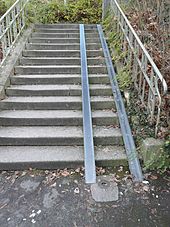Ramp (fixed access)
A ramp is a flat or inclined fixed access. In this sense, a ramp is not necessarily an inclined plane .
Demarcation
The term ramp as an approach or driveway is colloquially associated primarily with use by vehicles. A motorway connection z. B. is therefore also seen as a ramp, but not as access to building access .
In this sense, access is not a ramp if a staircase with its typical incline is supplemented by an inclined plane so that pedestrians can easily overcome it with shopping carts or prams. The inclined plane can be viewed as a ramp in itself, but not as an independent access.
The term loading ramp has become established for ramps that are used as a mobile route or access .
to form
Building driveways
If buildings are not level, access is made possible by ramp systems. This is the case both when the building is on a hillside and when the main floor is not at ground level.
Many castles, but also other public representative buildings, have driveways in front of the main entrance so that one could get directly into the building from the carriage. These ramps are often combined with staircases, roofed over in the manner of a vestibule or integrated into porches, and are particularly representative. Located in a park, the driveway extends as a whole from the outside gate to the palace forecourt or courtyard. The access ramps are a central part of the construction of castles, which by their nature are mostly elevated. This can be found analogously as a garage driveway in residential buildings when the street level is lower.
Corresponding constructions of a purely practical nature can also be found in commercial buildings or systems of all kinds, up to mountain farms, in the entire transport sector or in military buildings.
Loading docks
The loading ramp is used to transfer materials and goods between the building and the transport vehicles. Since the floor level of the building is usually adapted to the loading area level of the vehicle, loading ramps are consistently level extensions and front extensions, and only secondarily are supplemented by inclined ramps for small mobile devices.
Boat ramp

The boat ramp or slipway is used to lower boats from land into the water.
Ferry ramp
A ferry ramp , as well as a NATO ramp, is used to create a car ferry and to drive vehicles on and off.
Stair ramps
If it follows geographical conditions or is part of medieval buildings, it is partially designed with steps. The resulting hybrid form of ramp and stairs is called a stair ramp, the boundary is around 20 ° staircase incline, below this incline you usually have to take two steps per step as a basis, more incline becomes complex or strenuous with a rolling device. The disadvantage here is that stair ramps are only conditionally suitable as driveways for wheeled transport (wheelbarrows, wheelchairs, etc.).
Accessibility
Nowadays, ramps are usually created as access roads suitable for the handicapped with a maximum gradient of 6%, i.e. a maximum gradient of approx. 3.4 °. In this case, the dimensions, attachment and design in Germany are also based on the requirements of the standards
- DIN 18025 Barrier-free apartments; Apartments for wheelchair users; Planning principles
- DIN 18024 Barrier-free building: streets, squares, paths, public traffic and green areas as well as playgrounds; Planning principles
- DIN 18035 Sports fields - Part 1: Outdoor facilities for games and athletics, planning and dimensions



